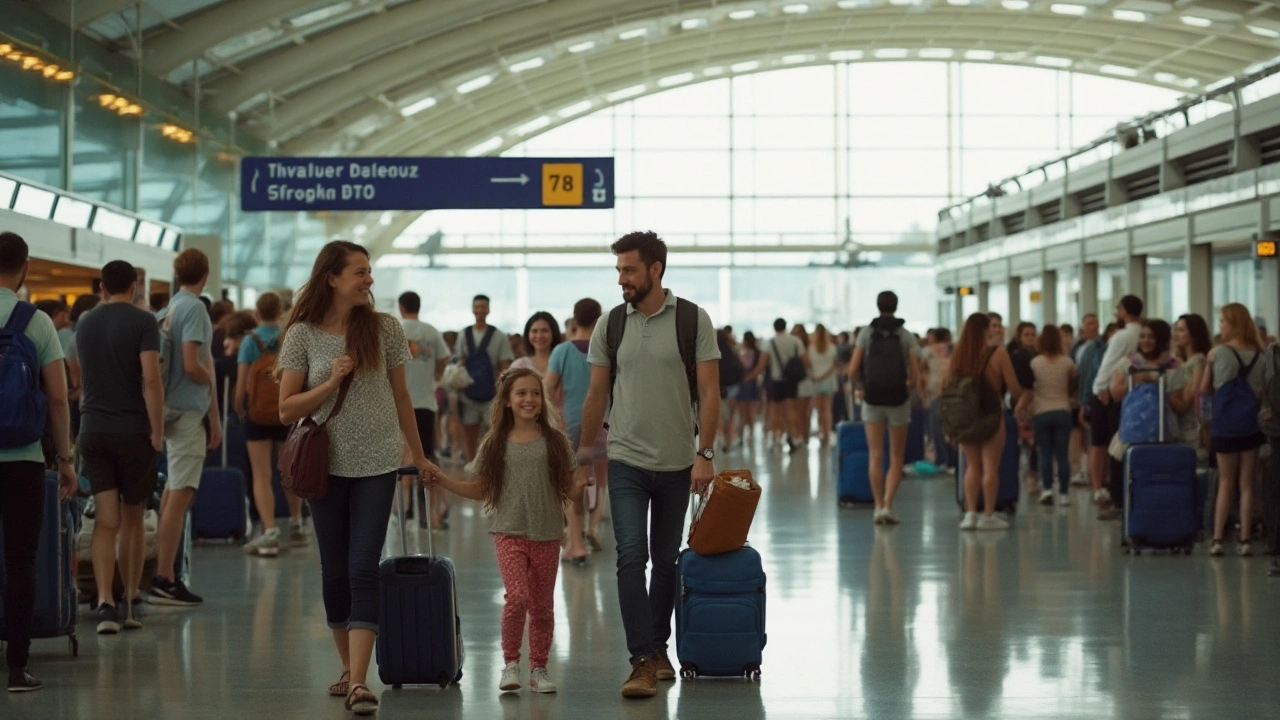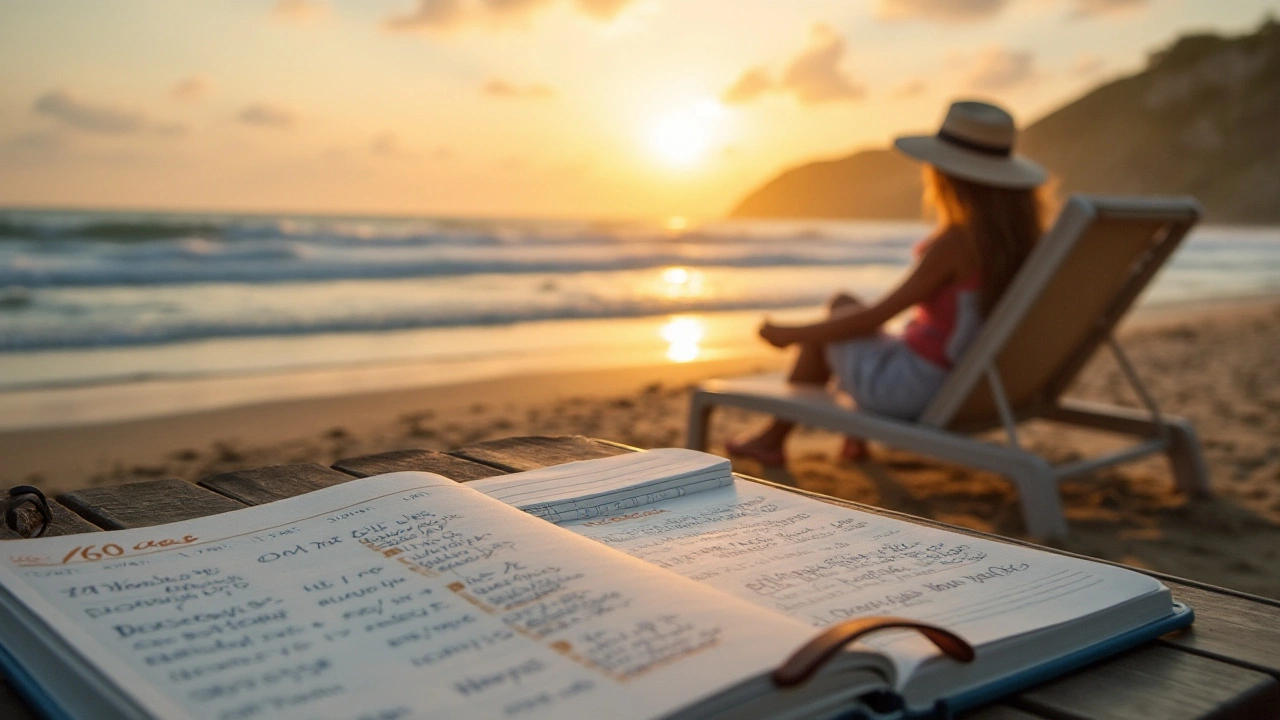Maximizing Your 20 Days of Paid Time Off: A Guide to Last Minute Holidays
 Nov, 22 2024
Nov, 22 2024
When it comes to Paid Time Off, the magic number often tossed around is 20 days. But is it truly enough to recharge and satisfy our wanderlust? Balancing work responsibilities with the desire for spontaneous adventures can be a challenging dance, yet it's one worth perfecting. Exploring the potential of your PTO can transform those days into meaningful escapes.
In today’s hustle-driven culture, making the most of our days off becomes an art form. Understanding the intricacies of PTO and how it fits into the mosaic of our lives is essential. Whether you're dreaming of remote beaches or vibrant cities, effective planning is the keystone. We'll uncover how 20 days can surprisingly stretch far beyond their immediate promise.
- Understanding the Value of PTO
- Effective Time Management
- Spontaneous Travel Tips
- Maximizing Travel Adventures
Understanding the Value of PTO
In today’s fast-paced world, where burnout and productivity pressures mount, the concept of PTO—or Paid Time Off—stands as a beacon of balance and sanity. It’s more than just a corporate benefit; it’s a gateway to well-being, giving employees much-needed time to refresh and recharge. According to the U.S. Travel Association, employees left a staggering 768 million days of unused PTO in 2019, highlighting a missed opportunity for many to harness this time effectively. This number alone speaks volumes about how even though time off is provided, it’s not always utilized to its fullest potential. Understanding the intrinsic value of these 20 days can transform our professional and personal lives alike.
The value of PTO rests not just in the days off, but in how these days contribute to reducing stress, enhancing mental health, and boosting overall productivity. Studies have shown that employees who regularly take vacations are less likely to suffer from stress-related disorders, giving them a chance to decompress. This doesn't just apply to lengthy breaks; even short, well-planned respites can significantly impact one's work-life satisfaction. By utilizing your PTO, you foster a happier, more motivated mindset which, in turn, translates to an invigorated work ethic. According to Harvard Business Review, taking time off resets your brain, improving creativity and problem-solving skills.
"Time away from the constant grind is crucial for maintaining both productivity and sanity," says Laura Vanderkam, author of What the Most Successful People Do at Work.
Yet the challenge remains: how do you shift the perception of PTO from a luxury to a necessity? Many companies are beginning to realize the advantages of encouraging employees to use their allotted days, understanding that last minute holidays or spontaneous breaks can lead to unexpected boosts in creativity and morale. Employers are now more open to cultivating a culture that embraces these breaks as a vital component of a healthy work environment. Importantly, it is essential to address the apprehension that taking time away may reflect negatively on one's work commitment. Changing this narrative is pivotal.
Enhancing the value of vacation tips within PTO involves practical planning and smart execution. Appreciating different vacation models, such as staycations, digital detox retreats, or adventure travels, can help maximize experience without depleting financial resources. It encourages a broader perspective on holidays, making each day count significantly. Whether it’s a local escape or an exotic retreat, employing effective time management can ensure you get the best value from these days off. An unexpected benefit to understanding this value lies in its ability to reshape your approach to work, creating a healthier, more proactive routine upon return. The PTO exists as a tool that, when employed well, serves to enrich life, work, and well-being.

Effective Time Management
As we juggle with 20 days of PTO, strategic planning becomes our ally in maximizing these precious hours of freedom. Effective time management begins with understanding the work calendar. Identifying the year's public holidays and long weekends early on can present a golden opportunity to extend vacations without dipping heavily into your PTO bank. Secure these blended vacation days as soon as possible since they tend to be in high demand.
Consider breaking down your PTO into smaller segments to pace your relaxation and exploration through the year. While the idea of taking a full chunk at once may be tempting, spreading days across months can help maintain a consistent work-life balance. According to a study by Project: Time Off, people who plan their vacations tend to maximize leave effectively and have a higher probability of using their full days off annually. They report feeling more satisfied in their personal and professional lives, attributing it to regular doses of respite.
"The key to successfully maximizing vacations lies in anticipation," notes travel expert Samantha Brown, "when you plan not just the trip but the anticipation leading up to it, you get more enjoyment, starting months before you even take the flight."Another effective strategy is to create a buffer around your travels. Instead of rushing back to work the day after a long flight, aim to return with at least a day to reorient at home. This transition time can be immensely beneficial for reducing travel fatigue and looming stress.
Don't discount the value of virtual tools in orchestrating your PTO. Apps and planners like Google Calendar or Asana can sync family schedules, work commitments, and travel plans seamlessly. Use these tools to block off time for personal errands and relaxation before and after your trips. Being deliberate about rest amidst busy schedules can counter the typical stress associated with returning to work. Finally, avoid overlooking daily habits that can align with your PTO goals. For instance, cultivating more efficient productivity habits at work can sometimes mean accomplishing tasks in less time, freeing up additional breathing room for travel planning.
In essence, smart time management combined with creativity allows you to fully harness the potential of 20 days of PTO. This proactive approach doesn't just result in more trips; it also optimizes the quality of your downtime, ensuring that each holiday begins and ends with elevated well-being.

Spontaneous Travel Tips
Embarking on a spontaneous trip can seem daunting, especially with just 20 days of PTO at your disposal, but diving into an unplanned adventure is often where the most memorable experiences lie. The key to spontaneous travel is flexibility—both in mindset and itinerary. Start by keeping a travel bag ready with essentials: versatile clothing, travel-sized toiletries, and any gadgets you may need on the go. While the urge to plan every detail might be strong, leave room for serendipity. Embrace the unknown and allow chance encounters and newfound local spots to dictate part of your journey.
Choosing a destination is the pivotal first step. Opt for places that can be reached within a few hours: a hidden gem of a city, a national park, or even a quieter, less-known beach town. Sites like Skyscanner or Google Flights have this nifty feature called 'Explore Destination', which helps you find flights within budget constraints or at the last minute. This way, your last minute holidays can begin with adventure right from the planning stages. According to the U.S. Travel Association, nearly one-third of vacations are taken on the spur of the moment. With a strategic approach, these trips can be just as rewarding as meticulously planned getaways.
A major factor in spontaneous trips is accommodation. Here’s a tip: lean on platforms like Airbnb or Booking.com, which often have last-minute deals or discounted rates for same-day bookings. However, if you wish to experience something unique, consider home exchanges or couch surfing options, where you'll not only save money but also meet locals who can offer invaluable insights into the area. Remember, the less predictable the plan, the more you'll engage with the destination's genuine culture. As travel writer Paul Theroux says, "Travel is glamorous only in retrospect."
Budgeting is vital when planning impromptu travel to ensure your adventures don’t lead to financial stress. Enlist the help of budgeting apps to track spending efficiently; applications such as Mint or Wally are popular choices that keep expenses in check. Sticking to street food or local eateries instead of mainstream restaurants can not only save costs but also provide an authentic taste of the locale. A spontaneous trip doesn’t necessitate splurging on every aspect; rather, it highlights prioritizing authentic experiences over luxury.
Finally, travel insurance might not seem essential during hurried planning, but it's crucial for short-notice trips. Emergencies aren't exclusive to long vacations, and having coverage offers peace of mind for any unforeseen circumstances. Adventure insurers like World Nomads can cover both medical and trip-related quagmires, leaving you free to immerse in the moment. So gear up and let the spontaneity of your vacation unlock new experiences. The stories you'll bring back will be invaluable, not because of how much you spent, but due to the richness they added to your life's narrative.

Maximizing Travel Adventures
When you're staring at a calendar with 20 days of PTO at your disposal, every minute counts if you want to squeeze out the maximum joy possible from your travels. First, consider choosing destinations that offer a rich tapestry of experiences closely knit together. Think of cities like Lisbon, where you can spend the morning in historic neighborhoods, the afternoon surfing Atlantic waves, and the evening indulging in fado music and delectable pastries. By selecting diverse locations, your getaway can feel like several mini-vacations packed into one.
Balancing high energy activities with restful relaxation allows both body and mind to fully unwind. Instead of cramming full itineraries, pace yourself with a mix of exploration and leisure. Martin Luther King once said,
“Take the first step in faith. You don’t have to see the whole staircase, just take the first step.”Approaching travel with this mindset encourages you to savor each moment without the pressure of ticking every box on a list. In terms of practical tips, combining short-haul flights with a few longer stretches can save valuable time and reduce fatigue when traveling.
Another key strategy is to consider alternative travel times. Flying on a Tuesday or Wednesday typically provides not only cheaper fares but also less crowded experiences, freeing up funds and patience for authentic local splurges. An interesting fact: According to a study by the Harvard Business Review, spreading out vacation days to take multiple short trips can result in more happiness than one long annual vacation. This can be tied to the anticipation of each upcoming adventure and the fresh, revitalizing break each one promises.
For families, exploring lesser-known attractions during off-peak seasons can lead to surprising discoveries and a more in-depth cultural immersion. Returning home with stories of hidden gems adds a unique twist to your travel tales. As you blueprint your trips, ensure you factor in time for spontaneity. These unplanned moments often become the highlights, transforming a simple walk into a serendipitous dinner invite or a lazy river drift into a cherished connection.
Should you find yourself paralyzed by choices, consider themed vacations to streamline decisions; a culinary tour, a history deep-dive, or an adrenaline-pumping adventure itinerary can add structure while keeping the experience broad. This approach allows you to focus on specific interests, ensuring that your limited time is spent doing what truly excites you. Remember, the key to a memorable holiday is not how many places you visit, but the richness of the experiences you accumulate.
Ultimately, maximizing your travel adventures lies in thoughtful planning, flexibility, and an openness to unexpected opportunities. With just 20 days of last minute holidays a year, every getaway can be a unique story, waiting to unfold and enrich your life. Embrace being a traveler, not just a tourist, and let the journey itself be your greatest reward.
